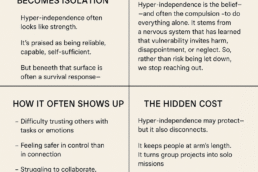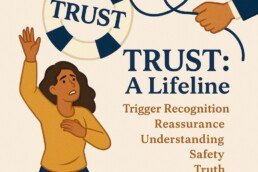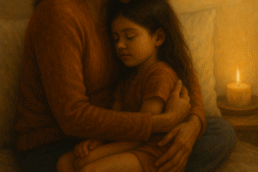The Impact of Learned Behaviour
Early Experience
Most of the relationships throughout our lives influence our behaviours, both positively and negatively, frequently both. We are constantly learning and absorbing new information, new language, perspectives, ideas and beliefs from each other. Politics, Fashion, Music, Food, Hobbies & Interests, Goals, Habits and much, much more. Original thought is rare, almost everything is influenced by others.As infants we learn to imitate and mimic behaviour, processing information through our senses - this is how children learn and grow. This is all good and well the behaviour is healthy, positive, encouraging and supportive. As children we learn to feed ourselves, brush our teeth, learn how to dress, develop friendships, ride a bike,, care for a pet etc. We copy and practice, getting it wrong, until we eventually get it right. Our early relationships our shaped mostly by our primary care givers; parents, step-parents, grandparents, siblings, teachers, relatives, neighbour's & friends.
The developing brain of a child does not distinguish between positive and negative behaviours, a example; when an adult curses in front of a child and the child spends the rest of the day repeating the curse word. Research shows that a child's brain is not fully developed until the age of 25 years, with the frontal cortex being the last part of the brain to develop. The frontal lobe is part of the brain's cerebral cortex. Individually, the paired lobes are known as the left and right frontal cortex. As the name implies, the frontal lobe is located near the front of the head, under the frontal skull bones and near the forehead, the place your hand often reaches for whenever you are feeling the impact of stress or confusion.
The frontal lobe plays a role in many higher level functions of your brain. This can include:
voluntary movements (which are movements you control) of the opposite side of your body. sequencing of complex or multi-step movements, such as getting dressed or making a cup of tea
This may explain why many of us feel or are considered awkward or clumsy as teens and young adults.
speech and language production in the dominant frontal lobe (opposite your dominant hand) attention and concentration -
Our brains can only focus for between 90 to 120 minutes before it needs a break, according to sleep researcher Nathan Kleitman, who introduced the notion of the Ultradian Cycle in the 1950's. Power naps, meditation, mindfulness - listening to the natural rhythm of our bodies is all considered healthy behaviour. This may explain why many of us fall into a daydream state when we've been studying/working for too long without a break.
working memory, which involves processing recently acquired information reasoning and judgment organization and planning problem-solving regulation of emotions and mood, including reading the emotions of others personality expression motivation, including evaluating rewards, pleasure, and happiness impulse control controlling social behaviours
What happens when a parent displays extreme behaviours such as Anger, Aggression, Violence, Addiction, Manipulation for example?
What happens when a parent spends the majority of their time with their attention on their social media feed, or are regularly playing games depicting realistic violent or horrifying graphic imagery?
While the child themselves may not be playing the age restricted game, if they are nevertheless subjected to graphic imagery – what impact does it have on the child – what is the child learning? Is there any evidence to suggest the potential for damage?
According to Education Neuroscience, in a recent meta-analysis of 98 studies, involving 36,965 participants, violent video games were convincingly shown to influence social behaviour. http://www.educationalneuroscience.org.uk/resources/neuromyth-or-neurofact/violent-video-games-make-children-more-violent/[Source]. The fact that studies have taken a variety of forms strengthens the certainty of the relationship.
Confidence & The Developing Brain
It stands to reason that when children are encouraged and supported from an early age, influenced positively by the primary care givers and permitted to learn, grow and develop in a calm and stable environment, and allowed to make mistakes without being made to feel less than or chastised unnecessarily – the child is far more likely to grow up confident, with a positive self esteem, enabling them to form happy and healthy relationships, and live happy and healthy lives, while the opposite is also likely.
If as the research suggests, problem-solving, personality expression, motivation – including evaluating rewards, pleasure and happiness, reasoning and judgement and impulse control, are the last things to develop, the child’s future life and well-being is at the mercy of the care-givers. If the primary care-givers are not fully developed, are emotionally immature or have themselves been negatively influenced in childhood – a cycle of negative learned behaviours may occur. If unresolved trauma is experienced by the care-givers, it is reported by researchers that generational trauma is a possibility.
‘Transgenerational or intergenerational trauma as it is also known, is a traumatic event that began decades prior to the current generation and has impacted the way individuals understand, cope with, and heal from trauma. Intergenerational trauma was first recognized in the children of Holocaust survivors, when in 1966, psychologists began to observe large numbers of children of Holocaust survivors seeking mental help in clinics in Canada. The grandchildren of Holocaust survivors were overrepresented by 300% among the referrals to a psychiatry clinic in comparison with their representation in the general population. Since then, transgenerational trauma has been documented in descendants of slaves, Native Americans, war survivors, refugees, survivors of interpersonal abuse, and many other groups. [Source]
According to Best Selling Author. Life Coach self made Multi-Millionaire Rock Thomas, on average children are subjected to 100,000 put-downs by the time they reach 14 years of age, imagine the impact that a single put-down can have on an adult.
As we grow up, many behaviours become ingrained. We respond automatically because that’s all that we know. One of the ways in which our brains work, known as ‘Bottom-Up Processing – drawing on past experiences and filling in the blanks with what it already believes to be true. Many of us in our 50’s and older, were brought up in an era when children’s rights, although established, were rarely considered. The outdated belief that children should be seen and not heard, that Parents made all the decisions and children did as they were told – or woo be tide! Back when honor thy Mother and thy Father was the order of the day in many UK households.
As parents/caregivers, the majority tend to do what they believe to right by the child; teaching them right from wrong, good from bad, all the things that we believe will set them in good stead for a happy, healthy future. But what when our behaviours as caregivers is automatic? Learned behaviours that we are not consciously aware of handed down by the traumatized, under developed brains of our ancestors!
As parents we often fall into the habit of overriding our children’s choices, usually with the best of intentions but without actually realizing we are doing it, and by doing so, we can inadvertently overlook serious issues that the child is trying to tell us but maybe doesn’t have the language to be able to put into words what is happening to them or to express how they truly feel;
Child: “I don’t like sprouts”
Parent: “Eat them up, greens are good for you”
Child “I’m not tired” –
Parent “It’s time for bed, you need your sleep”
Child “I don’t want to go swimming with Uncle Bobby”
Parent “Don’t be silly, he’s waiting – go and fetch your swimming kit”
When we get into a habit of automatic responses, red flags can be easily missed.
Core Beliefs
When an adult/caregiver teaches a child from an early to think negatively about themselves, or behaviours inappropriately towards the child, the child, who is not yet fully able to understand what or why the adult is behaving in this way, tries to make sense of the behaviours. The inexperienced, developing youngster applies meaning to the adults behaviours in order to try to make sense of it, often coming up with the wrong answer entirely- “Its my fault X is angry, its my fault X is leaving, – I am always the one to blame!”
This kind of reasoning shapes the child’s thinking, and this becomes the child’s Core Beliefs. They may grow up feeling guilty, stupid, useless or worthless and struggle to understand why.
Beliefs are thoughts that we keep on thinking, nothing is static – thoughts can be changed, beliefs can be unlearned and relearned and people can change and heal and go on to live happy fulfilling lives.
If you identify and would like support, please Get In Touch or, if you would like further information relating to learned behaviours and how they can impact our lives, our Blog posts provide further insight into lived experiences and can be accessed below.
Emotional Immaturity
Emotional immaturity can be the result of getting 'stuck' in emotional development due to trauma. In her ground-breaking book 'Rescuing the Inner child', Penny Parks, a pioneer and expert in the field of childhood abuse and the creator of the Parks Inner Child Therapy model (PICT), the author explains how the traumatic impact of abuse often 'freezes' a child's emotional development at the point of when the abuse occurred.
Many victims are confused and struggle to understand what constitutes abuse. It may make sense to them that if a person is beaten, punched, kicked, raped, starved - essentially the abuse involves violence, it is clear to the victim that the act is abusive, although they may still not identify as a victim themselves, even when subject to violence. There are many forms of abuse, that are covert and invisible to the naked eye, and that do not include physical violence; such as emotional abuse for example.
What you experience is unique to you. Whether or not you experience an incident as traumatic depends on the kind of support you received while coping with it. What feels traumatic to one person, may not be experienced that way by another. How an event is perceived is a relative personal experience.
Getting stuck/frozen, happens when you did not receive enough love and security while you were going through the traumatic events. When you feel terrified, lost, humiliated, ashamed, guilty, worthless and helpless, and there was no one there to comfort you, defend you or stand up for your rights. Because of this, you became too afraid to continue to take the emotional risks that are necessary for future growth. You were made to feel vulnerable, which is a normal emotion and natural way to feel. In normal circumstances, you may have faced the feelings of vulnerability and learned from them, allowing you to grow emotionally. However, because you experienced deep pain and fear, knowing no one was there to help, instead of growing from the experience, you created a protective barrier around yourself, especially around your heart. While your body grew, the barrier grew in height and depth, protecting you from more painful experiences you didn’t get any support for. As you got older it became more constricting and your inability to cope with life in a healthy manner became more evident.
Types of trauma that lead to emotional freeze can be a physical event such as an earthquake, flood or fire. It can be the result of a single incident or a prolonged period of physical, sexual or emotional abuse. It can be the death of a close family member or friend or the chronic illness of a parent. It can also be a much less dramatic event, such as moving to a new place and not feeling like one belongs or being bullied or shamed by peers. Research studies have showed that adverse childhood experiences (ACEs) significantly contribute to negative adult mental and physical health.
Less visible forms of Caregiver/Parental abusive behaviours towards a child/ adult child often take place in the home behind closed doors. A child at the mercy of abusive caregiver behaviour is unlikely to recognise the abuse, accepting the behaviours as 'just how it is'. These behaviours may include;Read more
Abusive Relationships
LIFTING THE FOG
Before you can begin to cope with an abusive relationship, you must first be able to recognise that it's abusive.
The very nature of the abusive relationship can leave victims confused and uncertain of which way to turn. They will often question whether the relationship is indeed abusive, or if the problem is with them; “I’m over-sensitive” ” I take things the wrong way” or ” I’m reading too much into it”, ideas reinforced by the abuser.
Abusers are extremely manipulative. Understanding the 3 C’s of Manipulation and how they work, may help to lift the fog of confusion.
CONTROL
People who set out to manipulate and abuse others, begin by taking control of the situation. They will use their knowledge, skills and powers of persuasion to talk people into things that they may not otherwise be inclined to do.
CONFUSE
People who manipulate and abuse others, aim to confuse. They may overwhelm their victims with information, focusing and narrowing their attention and preventing them from ‘stopping and thinking’. This may be experienced by the victim as overwhelm or bombardment. Should the victim be given the opportunity to stop and think, they may realize how awkward or uncomfortable they feel, which is dangerous territory for a manipulator who has an agenda
COMPROMISE
Abusers often use a technique that I refer to in the training as the Invisible Seduction, which aims to influence the victim and coerce them into the manipulator’s way of thinking.
The manipulator’s intention is to reach an outcome that is advantageous or in some way beneficial for themselves, often, without giving consideration to the victim.
An unsuspecting victim may assume they are reading too much into a manipulator’s actions, failing to recognise the manipulator’s true intentions.
As a result, the victim is often left confused and compromised, having inadvertently responded in a way that may not be of their choosing and which may not reflect the victim’s true values or beliefs.
Abusive Relationships
LIFTING THE FOG
Before we can begin to cope with a toxic relationship, we must first be able to recognise that it's toxic.
The very nature of the toxic or abusive relationship can leave victims confused and uncertain of which way to turn. They will often question whether the relationship is indeed abusive, or if the problem is with them; “I’m over-sensitive” ” I take things the wrong way” or ” I’m reading too much into it”, ideas reinforced by the abuser.
Abusers are manipulative by nature, recognising the abuse is the first step to escaping it, accepting the relationship is abusive is the next important step.
Quite often the person we are in an abusive relationship with is someone we care about; a partner, a parent or caregiver, a sibling, relation, colleague or friend. Even though we may ‘feel’ something is ‘wrong’ in the relationship, accepting the person we love and respect is or has been abusive is a massive step to take. Victims rarely recognise themselves as victims until someone points it out to them. “Don’t let them bully you” or “Why do you allow them to treat you like that”, might be the first clue someone has that they are in an abusive relationship. You may have heard of the saying ‘Love is blind’ – for some people, it really can be.
Gaslighting often plays a huge part in toxic relationships.
Gaslighting is a form of psychological and emotional abuse that causes victims to doubt and question their own judgement, reality, self-perception and sometimes their sanity.
Gas-lighters twist and distort the truth in order to manipulate, confuse and control their victims. The paranoid abuser may regularly accuse the victim is ‘telling tales out of school’, worried that outsiders might learn the truth about their unhealthy behaviours. Victims rarely speak ill of their abusers – the accusations reinforce the idea that it is they who are the issue – liars or gossips betraying their ‘loved one’ when in fact, nothing could be further from the truth. Victims regularly protect their abusers; the last thing they want is to have people speaking bad of them, after-all, it is the victim who will suffer the consequences should such a scenario occur.
Gaslighting is only one aspect of manipulation used by an abuser. When we care about someone, especially someone who appeared to be ‘perfect’ in our eyes in the initial stages of the relationship, it can be difficult for our heart to accept what our heads already know to be true!
Understanding the 3 C’s of Manipulation and how they work, may help to start lifting the fog of confusion and seeing things as they really are.













